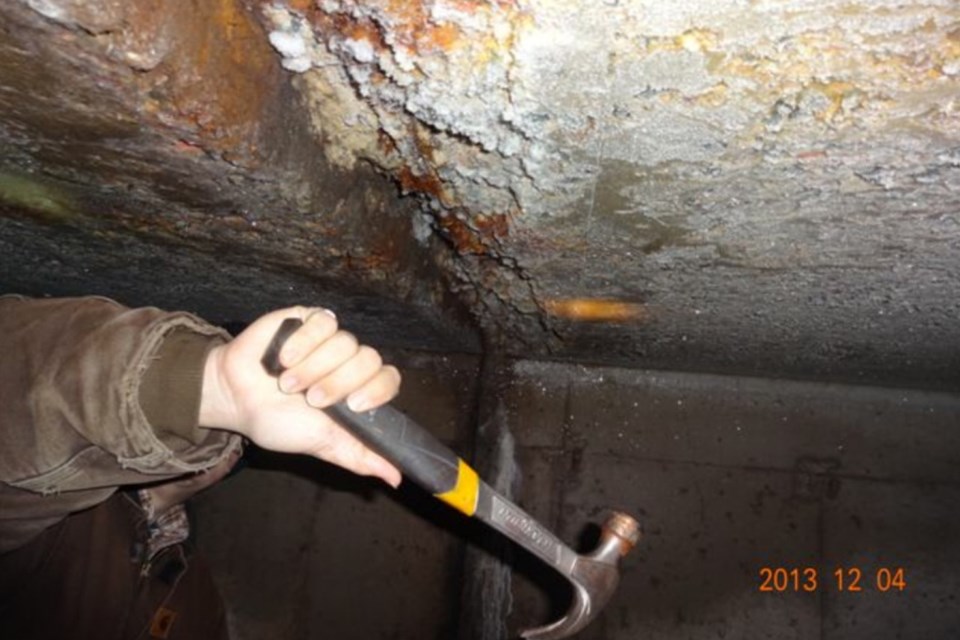Poke around under the sidewalk, all along the south side of Wellington Street West from John Street to Carmen's Way, and you'll find Fort Creek.
More precisely, you'll find Fort Creek flowing through a big, century-old, man-made subterranean passageway on its way to the St. Marys River.
For more than 100 years, Saultites have been diverting, channeling and paving over Fort Creek as they built a community and tried to control flooding.
Early city maps show the creek originally meandering further east, through the Parliament St. area.
Today, a short section at the CPR Railway bridge near John Street is one of very few places where the original creek bed still survives.
Along Wellington Street West, past places now called Mobile Glass, Discover the Canvas tattoo parlour, the Peking Palace Restaurant, Paesano's and Revive Hair Salon, Fort Creek was boxed in 1912-1913 into an underground concrete culvert from 1.8 to 2.0 metres high, and between 2.3 to 4.9 metres wide.
It's called the Fort Creek aqueduct. It's still there, just under the sidewalk. It's still carrying the waters of Fort Creek toward the river.
It's in bad shape and city officials are preparing to rip up the south side of Wellington St. this year to install a new aqueduct with greater capacity to handle stormwater when needed.
Details of the project were unveiled on Wednesday at an open house at the Civic Centre.
"The existing aqueduct has structural deficiencies and portions may be undersized to carry major rainfall events," says a report prepared last year by Tulloch Engineering.
"Sections of the structure are over 100 years old and there is an increasing need for emergency repairs as evidenced by sudden localized failures occurring in the roof slab. The safety of pedestrians and motorists is of concern. In addition to the structural adequacy, the hydraulic capacity of the aqueduct also needs to be evaluated for adequacy to accommodate current storm design flow standards," the report concluded.
"There is an apparent increase in high-intensity precipitation events over the past few years which has resulted in area flooding. The potential for future flooding can be reduced if during the replacement of this drainage system its capacity to carry storm water is increased where needed."
Aqueduct route
The Fort Creek aqueduct consists of sections of concrete culvert sections punctuated by open channels.
It starts up on Second Line at the Fort Creek Conservation Area reservoir.
From there, it dips under Second Line east of Carmen’s Way, then running as an open channel to White Oak Drive.
There, the aqueduct goes underneath Carmen’s Way, flowing in an open channel along the west side of Carmen’s Way to Wellington Street.
Then, the culvert crosses under Wellington and turns east, proceeding along the south side of Wellington, its 12-inch-thick roof slab forming the sidewalk.
At St. Andrews Terrace, the aqueduct runs south as an open channel for about 70 metres, then going east under John Street to the backyard access laneway east of John.
From there, the aqueduct runs south, crossing Esposito Park to the south side of Queen, where it flows into an open channel at the casino, then into the St. Marys River.
"In 2013 a lot of vegetation was removed from the open channel down to the casino bridge to improve the flow capacity south of Queen St.," Stem Engineering said in its 2015 inspection report.
Bad shape
The aqueduct is inspected every second year.
Here's what recent engineering reports have found:
- spalled (flaking off) and missing concrete
- missing parging (sealing) around pipes
- debris accumulation
- substantial cracking
- severely rusted I-beams in poor condition
- exposed rebar
- delaminating concrete
- holes in slab
"Many of these areas have roof slabs which have exposed rebar on the underside, and steel roof beams which are delaminating," Stem Engineering reported after its 2015 inspection of the aqueduct.
"Many of the culvert sections have layers of mud and debris and should be cleaned out on a regular basis. Sections of this aqueduct have been replaced in the last few years, including the section under Queen Street."
An environmental assessment related to the Wellington Street construction work was completed last year.
It's the latest phase in a $32 million initiative to rebuild the aqueduct from Carmen's Way to the river, with the city, province and federal government each contributing one-third of the funding.
At the open house on Wednesday night, Carl Rumiel, a design and construction engineer with the city, said the job will go to tender this Saturday, with the tender process expected to take about one month.
Some intermittent road closures will be necessary, but for most of construction season, Wellington Street traffic will be maintained in both directions, Rumiel told SooToday.
